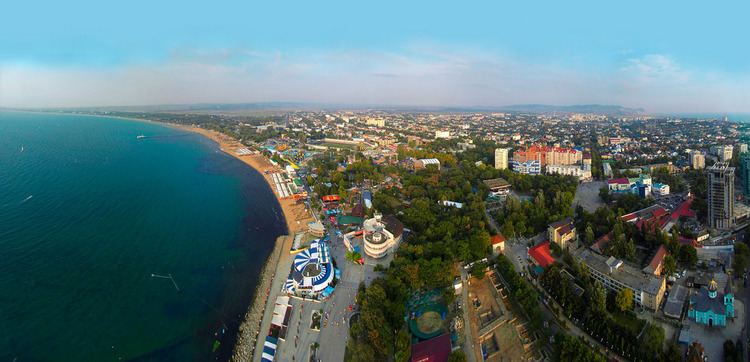Coat of arms Flag Urban okrug Anapa Urban Okrug Number of airports 1 | Country Russia Administratively subordinated to Town of Anapa Local time Thursday 12:56 AM Founded 14th century | |
 | ||
Weather 13°C, Wind SE at 6 km/h, 49% Humidity Points of interest Waterpark "Golden Beach", Tiki‑Tak, park im 30‑letiya Pobedy, Anapa Archaeological Museum‑Reserve, Anapskiy delfinariy "Nemo" | ||
Russia city of anapa krasnodarskiy kray 2015
Anapa (Russian: Ана́па) is a town in Krasnodar Krai, Russia, located on the northern coast of the Black Sea near the Sea of Azov. Population: 58,990 (2010 Census); 53,493 (2002 Census); 54,796 (1989 Census).
Contents
- Russia city of anapa krasnodarskiy kray 2015
- Map of Anapa Krasnodarskiy Kray Russia
- Anapa krasnodar krai black sea russia hd travel
- History
- Administrative and municipal status
- Tourism
- Transportation
- Climate
- Culture
- Architecture and sights
- List of mayors
- Activities carried out in the town
- Twin towns and sister cities
- References
Map of Anapa, Krasnodarskiy Kray, Russia
Anapa krasnodar krai black sea russia hd travel
History
The area around Anapa was settled in antiquity. It was originally a major seaport (Sinda) for the Natkhuay tribe of the Adyghe people and then the capital of Sindica. The colony of Gorgippia was built on the site of Sinda in the 6th century BCE by Pontic Greeks, who named it after a king of the Cimmerian Bosporus. In the 2nd and 3rd centuries BCE, Gorgippia flourished as part of the Bosporan Kingdom, as did its guild of shipowners, which controlled maritime trade in the eastern part of the Black Sea. A fine statue of Neokles (a local potentate, son of Herodoros) was unearthed by Russian archaeologists and is now on exhibit at the Russian Museum. Gorgippia was inhabited until the 3rd century CE, when it was overrun by nomadic tribes. These tribes, of Circassian or Adyghe origin, gave Anapa its modern name.
Later the Black Sea littoral was overrun by successive waves of Asiatic nomads, including the Sarmatians, Ostrogoths, Huns, Avars, Gokturks, Khazars, Circassians, and Tatars. The settlement was renamed Mapa by the Genoese at the turn of the 14th century. Genoese domination lasted until the arrival of an Ottoman fleet in 1475. The Turks later built a fort against the Russian Cossacks. The fortress was repeatedly attacked by the Russian Empire and was all but destroyed during its last siege in 1829. The town was passed to Russia after the Treaty of Adrianople (1829). See Russian conquest of the Caucasus#Black Sea Coast. It was included in Black Sea Okrug of Kuban Oblast and was granted town status in 1846.
It was occupied by Ottomans between 1853-1856 during the Crimean War. It became part of Black Sea Governorate in 1896. Elizabeth Pilenko, later named as a saint in the Ukrainian Orthodox Church, was the mayor during the Russian Revolution. It became part of Kuban-Black Sea Oblast in 1920. During World War II, it was occupied and totally demolished by Nazi Germany with the help of Romanian troops between August 30, 1942 and September 22, 1943.
Administrative and municipal status
Within the framework of administrative divisions, Anapa serves as the administrative center of Anapsky District, even though it is not a part of it. As an administrative division, it is, together with three rural localities, incorporated separately as the Town of Anapa—an administrative unit with the status equal to that of the districts. As a municipal division, the territories of the Town of Anapa and of Anapsky District are incorporated as Anapa Urban Okrug.
Tourism
The town boasts a number of sanatoria and hotels. Anapa, Sochi, and several other cities along the Russian coast of the Black Sea have enjoyed a substantial increase in popularity since the dissolution of the Soviet Union, which left traditional Soviet resort cities in Crimea and Abkhazia on the other side of the national border. Anapa is served by the Anapa Airport.
Anapa, like the other Black Sea coast resorts, has a superb sunny summer climate. Anapa has beautiful, mostly sandy beaches. However, Anapa seldom attracts tourists from outside Russia due to its modest infrastructure and its inconvenient accessibility from Western Europe via Moscow or Krasnodar. Anapa remains an attractive and inexpensive option for Russians who prefer traditional Russian resorts to more expensive destinations.
Transportation
Transportation facilities include the Anapa Airport, a railway station, an international passenger port for small-tonnage ships, a bus station, and a network of highways.
Climate
Anapa has a humid subtropical climate (Köppen climate classification Cfa) at the lower elevations. Its average annual temperature is +12.4 °C (54.3 °F): +16.4 °C (61.5 °F) during the day and +9.0 °C (48.2 °F) at night. Average annual precipitation is about 560 millimeters (22 in).
Culture
The Town Theater of Anapa is located on Krymskaya Street. It was opened after the reconstruction of the Town Cultural Center. There are twenty nine public libraries including four for children. In 2010 the libraries of Anapa received more than 8,000 books, and magazines and newspapers were ordered costing more than 1,000,000 roubles, in addition, nine hundred CDs were purchased.
There is museum of Local History (Краеведческий музей) on Protapova Street.
Architecture and sights
List of mayors
Activities carried out in the town
Twin towns and sister cities
Anapa is twinned with:
